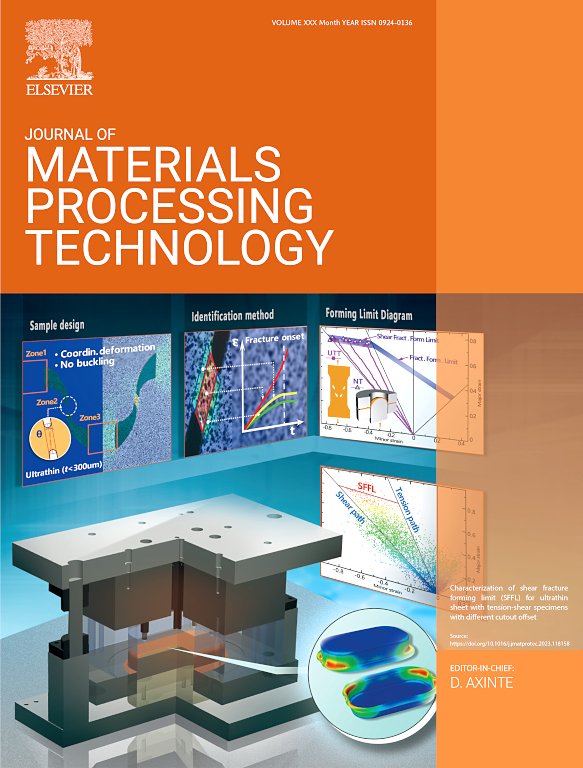Mechanisms in the machinability improvement of Inconel 718 superalloy through ultra-high-speed grinding
IF 6.7
2区 材料科学
Q1 ENGINEERING, INDUSTRIAL
Journal of Materials Processing Technology
Pub Date : 2024-09-25
DOI:10.1016/j.jmatprotec.2024.118614
引用次数: 0
Abstract
Inconel 718 (IN718) superalloy is a typical difficult-to-machine material characterized by low thermal conductivity and severe work hardening. Ultra-high-speed machining (UHSM) exhibits characteristics of material embrittlement and the skin effect of machining damage, which may address the above dual machining issues. This paper investigates the speed effect on the formation of machined surface and, for the first time, achieves ultra-high-speed grinding of IN718 superalloy at a speed up to 240 m/s. The grinding forces and surface integrity across various speed ranges are examined in detail. Multiple techniques are employed to characterize and analyze the subsurface microstructure. The results demonstrate that brittle-mode removal of IN718 superalloy occurs at a grinding speed exceeding 190 m/s, effectively mitigating work hardening and heat generation resulting from intensified plastic deformation. Furthermore, the machining speed influences the formation mechanism of recrystallization layer, gradually transitioning from discontinuous dynamic recrystallization (dDRX) domination to continuous dynamic recrystallization (cDRX) domination with an increase in grinding speed. Meanwhile, multifold nano-twins with a wide range of 4–5 nm form within tens of nanometer grains under UHSM conditions, further altering the subsurface microstructure. These findings provide valuable scientific insights for enhancing the machinability of other difficult-to-machine materials.
通过超高速磨削提高铬镍铁合金 718 超级合金可加工性的机理
Inconel 718 (IN718) 超耐热合金是一种典型的难加工材料,其特点是导热率低和加工硬化严重。超高速加工(UHSM)具有材料脆化和加工损伤集肤效应的特点,可以解决上述双重加工问题。本文研究了速度对加工表面形成的影响,并首次实现了以高达 240 m/s 的速度对 IN718 超合金进行超高速磨削。本文详细研究了不同速度范围内的磨削力和表面完整性。采用多种技术对表面下微观结构进行表征和分析。结果表明,在磨削速度超过 190 米/秒时,IN718 超耐热合金会发生脆性模式去除,从而有效减轻了塑性变形加剧所导致的加工硬化和发热。此外,加工速度还影响再结晶层的形成机制,随着磨削速度的增加,再结晶层逐渐从不连续动态再结晶(dDRX)为主过渡到连续动态再结晶(cDRX)为主。同时,在 UHSM 条件下,数十纳米晶粒内形成了 4-5 纳米宽范围的多倍纳米孪晶,进一步改变了表面下的微观结构。这些发现为提高其他难加工材料的可加工性提供了宝贵的科学启示。
本文章由计算机程序翻译,如有差异,请以英文原文为准。
求助全文
约1分钟内获得全文
求助全文
来源期刊

Journal of Materials Processing Technology
工程技术-材料科学:综合
CiteScore
12.60
自引率
4.80%
发文量
403
审稿时长
29 days
期刊介绍:
The Journal of Materials Processing Technology covers the processing techniques used in manufacturing components from metals and other materials. The journal aims to publish full research papers of original, significant and rigorous work and so to contribute to increased production efficiency and improved component performance.
Areas of interest to the journal include:
• Casting, forming and machining
• Additive processing and joining technologies
• The evolution of material properties under the specific conditions met in manufacturing processes
• Surface engineering when it relates specifically to a manufacturing process
• Design and behavior of equipment and tools.
 求助内容:
求助内容: 应助结果提醒方式:
应助结果提醒方式:


